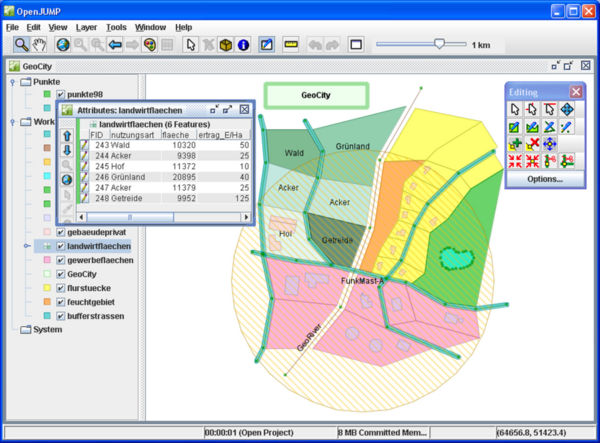JUMP
Inhaltsverzeichnis
Features
- a Java based GIS and programming framework, platform independent (Win, Linux, Unix, Mac)
- reads and writes ESRI SHP, GML files, DXF and PostGIS (with PlugIns)
- full geometry and attribute editing
- OpenGIS Simple Features compliant
- Geometry algorithms based on Java Topology Suite
- a lot of third party plugins exists (e.g connecting to Postgis database or ArcSDE, Raster files - e.g. tiff)
- easy extensible GIS programming environment for own GIS-applications
- supports a couple of languages (EN, FR, DE, ES, PT)
- free of costs
- OpenSource licence: GPL
The Beginning of JUMP an OpenSource GIS
In 2002, as a project for the British Columbia Ministry of Sustainable Resource Management, Vivid Solutions Inc. created a software program to do automated matching ("conflation") of roads and rivers from different digital maps. The software team wisely made the program flexible enough to be used not just for roads and rivers, but almost any kind of spatial data: provincial boundaries, power-station locations, satellite images, and so on. The program was named JUMP (JUMP Unified Mapping Platform), and it has become a popular, free Geographic Information System (GIS).
Why JUMP was left behind and OpenJUMP arose
After the initial creation and deployment of JUMP, regular development of the program by Vivid Solutions stopped. However, the company was gracious enough to continue offering support to the user community that had grown around JUMP, and answering the questions of developers that had begun to improve JUMP in small ways, or who had customized it to fit their needs. Martin Davis and Jon Aquino, two employees of Vivid Solutions that worked on the original JUMP, were valuable resources who played a key role in the growth of this community centered around JUMP.
It soon became evident that both the users and developers would benefit from a "unified" JUMP platform. This central or core platform would eliminate the compatibility issues that plagued the JUMP user community, and would give developers a platform on which to focus and coordinate their efforts. A number of the lead members from each team working with JUMP formed the JPP Development Committee, whose purpose was to guide and oversee this new unified platform. A name was chosen for this open source GIS program to be based on JUMP, "OpenJUMP".
Open formats and other technological stuff
One important feature of Jump and subsequently OpenJUMP is its abililty to work with GIS data in GML format. GML or "Geographic Modeling Language" is an "xml" (text-based) format for GIS data. It is a way to describe spatial information in a human readable form, and is an accepted "open standard" for GIS data.
OpenJUMP can currently read and write GML data, and the team hopes to develop a number of utilities that will improve OpenJUMP's ability to work with GML.
Why is the ability to work with an open format like GML so important to those considering implementation of a GIS? Because an open standard like GML frees a company or organization from the shackles of a commercial or proprietary data format. These commercial formats (for example, Autodesk DWG files or ESRI Shapefiles) are controlled by large commercial entities whose ultimate goal is profit, not compatibility and convenience for the user. But of course, OpenJUMP reads and writes ESRI Shapefiles and is therefore compatible to this quasi standard file format. Since a short time and additional to TIF files OpenJUMP also supports ESRI ASCII grid format by a specific OpenJump plugin from the SIGLE team. Thus, in spite that OpenJUMP is not a Raster-GIS it provides and will extend functionality to work with raster formats.
Jump GIS Related Web-Sites
- [1]: JUMP-Project – Website for the original version of JUMP
- [2] : Vivid Solutions - The company that created the original version of JUMP
- [3] : OpenJUMP - Wiki and community website
- [4] : JUMP Pilot Project - English info website of the support project JUMP-Pilot
- Kosmo : a JUMP based project from a Spain based company
PostGIS-Schnittstelle
Geometrie aus einer PostGIS-Datenbank darzustellen ist möglich über das Add-On PostGIS-Driver von Refractions Research.
